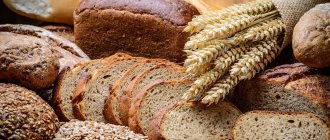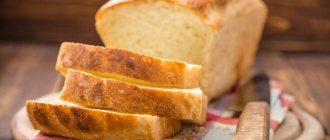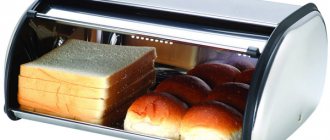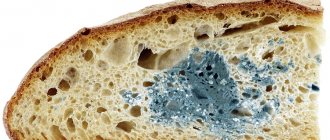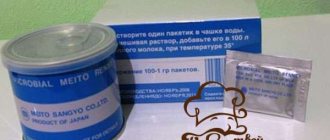Bread is loved by many and is perhaps the most versatile product. That is why it is important to know how to properly store bread so that it remains fresh and soft for as long as possible.
The rate of staling directly depends on the moisture content of baked goods. For example, crackers, biscuits and dryers practically do not go stale
Undoubtedly, the most delicious bread is freshly baked from a home oven or oven. The process of hardening is caused by a change in the structure of starch - its crystallization or, in scientific terms, retrogradation. Let's figure out how to properly store bread at home in the kitchen to slow down this process.
Bread consists of water and flour (starch and gluten). In the oven at high temperatures, starch absorbs moisture, its granules soften and an elastic crumb is formed. During the process of cooling and storage, starch transforms into its original crystalline state, releasing absorbed moisture. The bread loses its softness, elasticity and crumbles easily.
Why does bread quickly become stale, spoil and become moldy?
The loss of moisture that causes bread to go stale begins immediately after baking. Hot products are kept in air until the temperature is equal to room temperature, and then packaged.
If you put a hot bun in a bag, the moisture will continue to evaporate, condensation from the film will fall on the crust, and it will become soggy. Given its carbohydrate-rich composition, bread crumb serves as an excellent environment for fungi and bacteria.
Cooled bread continues to dry out, and the faster the lower the humidity of the room and the higher the temperature. Packaging helps preserve bread in the heat. If for most products refrigeration extends the shelf life, then for bread the decrease in temperature is limited. At 2°C the crumb becomes very dense.
Is it possible to store baked goods in the refrigerator: salvation or mistake?
According to housewives, flour products remain fresh in the refrigerator for 6-7 days.
To do this, it is advisable to follow the rules:
1. Remember that flour absorbs the odors of other foods. Therefore, it is recommended to put baked goods in the refrigerator in a container or bag.
2. It is forbidden to store bread that has not cooled down in the refrigerator compartment. Moisture collects on the walls of the package and the bun spoils.
3. Bread products that are beginning to mold should not be placed in the refrigerator. A lower temperature will not prevent the process. In addition, the pathogenic fungus will spread to the rest of the food.
Low temperature is considered a negative factor of this method. Chilled bread seems tasteless and loses its smell. The bun has to be reheated before eating. Many people don’t like the fact that it dries and hardens because the moisture evaporates faster than at the temperature in the room. And they choose a freezer.
How to properly store baked goods
The subtleties of storage are reflected in GOST 8227-56 for bread and bakery products. The standard was adopted in 1956. Despite improvements in production technology and the practice of improving additives, the standard remains relevant for production and for the home.
The storage location should be:
- permanent;
- clean, dry, well lit;
- away from odorous products and chemicals;
- not infested with insects.
Relative air humidity is assumed to be 75%, temperature - not lower than 6°C. In such conditions, rapid drying will not occur, but there will not be a favorable environment for mold growth.
How to restore freshness to a stale product
In order to restore freshness to stale bread, you can use the following tips:
- Sprinkle clean water on the loaf, put it in the oven for a few minutes at a temperature of 100-120°C;
- put the product cut into pieces in a colander, cover with a lid and hold over water brought to a boil for 2-3 minutes;
- warm up the loaf, use a thermos or thermal mug with a wide neck for further storage.
Dried bread can also be used as crackers. In this form, it will be useful when losing weight to remove waste and toxins from the body.
Bread is a valuable universal product with a short shelf life. In order to keep it fresh for as long as possible, it is important to responsibly select materials for packaging and other storage conditions. The shelf life of bread will also vary depending on its type.
How do you prefer to store baked goods? Share your experience in the comments, repost.
In what room
The room should be dry, clean and warm.
Bread crumb absorbs foreign odors.
The taste becomes especially unpleasant if a solution with the smell of bleach or petroleum products is spilled nearby. Therefore, bread is delivered in specially equipped vehicles with a sealed body and stored separately from “odorous” products and household chemicals.
The kitchen is in all respects suitable for storing bread, but even here it must be protected from the aromas of garlic and seasonings. Agree that buns with sweet filling and tea loaves with a hint of hot sauce will not appeal to everyone.
Difference between old and stale bread
In fact, many people don't know the difference between old and stale bread.
In past centuries, it was believed that properly prepared old bread had its own character. As loaves age, amazing changes occur. Surely everyone has noticed that after a couple of days the bread crust is no longer crunchy, but the taste becomes more harmonious and fuller. That is, old bread is sometimes even better in taste than a fresh loaf, which cannot be said about a stale product. The process when bread goes stale is called starch retrogradation in the scientific world. This term refers to the transition of starch polysaccharides from a soluble state to an insoluble form. In other words, changes that occur with starch during storage of bread.
Starch tends to constantly change. In a loaf of raw dough, the starch has a crystalline structure. But when the loaf is placed in the oven, the starch undergoes a process of gelatinization.
It is the starch, swollen under the influence of moisture and high temperature, that provides the bread with softness. However, during storage of the loaf, the starch compounds become more elastic, rigid and lose their elasticity. This leads to callousness.
Both the aging of bread and its staleness are inevitable processes. But even they can be delayed a little, preserving the taste and properties of the bread crust. It is enough to store baked goods correctly.
Is it possible to keep different varieties together?
Each person prefers his own type of bread. This is not a whim, but a requirement of the body. Technologists do not recommend mixing together white and black bread, rye and wheat, freshly baked homemade bread with stale bread in storage containers. It is better to place them in individual containers, bags, boxes.
Why you can’t store different types in one place:
- The composition of the microbiological environment depends on the starter or yeast used in baking. Joint storage can cause musty, unpleasant acidic odor in wheat buns;
- The percentage of moisture in some varieties is higher, in others it is lower. In one bread box, the moisture will be evenly distributed throughout the entire volume. For example, dry bread next to a bun will become moist and soft;
- white bread is more susceptible to foreign odors. Its aroma will be lost against the background of rye.
Is it possible to eat an expired product?
You cannot buy or eat expired rolls that have mold on them. This means that the product has lost its beneficial properties and can be harmful to health.
Signs of stale bread:
- it will have an unpleasant odor or no odor at all;
- becomes covered with plaque and mold may appear.
- when squeezed, it will not return to its previous shape.
Unlike moldy bread, the shelf life of stale bread can be extended by about a day. For this reason, it is allowed to use products that have lost moisture but retain their nutritional properties.
Ways to store bread at home
When we come to the store to buy bread, we always see one picture: loaves and buns lie on open wooden shelves. This is not always convenient at home.
How can you keep your bread fresh for as long as possible? After all, we don’t eat what we buy in a day. There are tons of storage options. You just need to choose the one where the soft crumb and crispy crust will last longer.
In a fabric bag
In bags made of linen canvas or cotton, the loaf will retain its natural aroma and taste for a week, but will become stale earlier than in a bread bin. The fabric is good for individual packaging of different types of flour products.
The bags are shaken out when a fresh loaf is placed, and washed once a month or earlier with laundry soap in hot water, as they become dirty.
In foil or plastic bag
Polyethylene and foil prevent moisture loss. The main thing is that the packaging is sealed. The loaf taken out of the bread machine is first cooled and wrapped cold. Bags and foil must be dry and clean.
In a refrigerator
The bread will last for three weeks in the refrigerator. This is convenient if the family does not eat a lot of bread. Cut into portions, it does not mold for a long time and is easily refreshed in the microwave. The bread should be in plastic or foil - there is too much humidity in the refrigerator.
In the freezer
It's good to store in the freezer when you have to leave for a long time. The bread will freeze, but once defrosted in the microwave it will regain its original freshness.
How to freeze correctly:
- portioned pieces are easier to warm without removing the whole bun;
- freshly baked bread is kept until completely cooled and only then frozen;
- Do not freeze the same loaf twice, it will become watery.
In the bread bin
The bread box is preferred for its portability. It can be placed in a convenient place and is easy to clean. The material and shapes are very diverse, so it will fit into any design solution.
Some people prefer to remove all utensils from tables and work surfaces. In this case, you can put the bread bin in a closet or make a shelf for it.
Opponents of this storage method are annoyed by the need to regularly wash the bread bin, so they prefer other options.
On the shelves in the kitchen unit
For those who don’t want to bother with drawers and boxes, the storage shelf will appeal to its ease of cleaning and spaciousness. To protect the surface from greasy stains and stains, you will have to store the rolls in bags and lay down napkins.
The packaging is also useful for protecting against kitchen odors, which are sometimes too intrusive. The closet door will not save you from this.
Containers built into the countertop
A hole of the required size is cut out in the tabletop and a container made of wood, metal, or a wicker basket is inserted. The lid is made in such a way that when closed it is flush with the entire surface. The secret compartment does not take up much space and preserves bread well.
Prevention
Since the fight against mold does not always bring positive results, it is recommended to direct all efforts to avoid its occurrence. To do this, experts recommend not buying products that will soon expire. Bread should always be fresh.
Important! It is prohibited to store bread in a plastic bag, since such packaging is most favorable for the growth of mold. Every week the bread bin should be wiped with a warm soapy solution and dried well.
It is better to place mustard plaster in the mold, since mustard is a natural antiseptic that protects products from mold. You can regulate the humidity level in the bread house using table salt.
Traditional option - bread box
Most housewives prefer a bread box. It justifies its purpose both in a small kitchen and in a spacious kitchen-living room. Which bread bin is best to choose based on design and material of manufacture is a matter of individual preference.
Material selection:
- made of plastic - as a neutral composition, it retains moisture and protects against foreign odors. These same qualities contribute to the appearance of mold and air stagnation. Treatment with acetic acid for prevention is recommended once a week;
- made of wood is the best bread box in terms of shelf life. If the wood has not been treated with impregnations or varnish, it does not produce foreign odors, but, on the contrary, accumulates them. To clean the top layer and disinfect it, treat it with boiling water once a month. Naturally, dry cleaning is carried out as needed;
- made of birch bark - an original type of bread bin, retains all the advantages of wood;
- made of ceramics - dishes made of neutral material best preserve the taste and aroma of any product. A ceramic pot or vase will keep the loaf fresh for several days. Unglazed ones are difficult to keep clean; glazed ones are not suitable for long-term storage, as they do not allow air to pass through;
- made of stainless steel - for those who prefer simplicity and conciseness, as well as for clean people. Metal can simply be wiped with a clean cloth. It doesn’t hurt to cover the bottom with a clean cotton or linen cloth and place a wooden board to preserve the taste of the bread;
- made of glass - bread bins protect against staleness and look stylish; in a small kitchen they do not burden the space. They are absolutely sealed, so it is necessary to prevent the development of fungus;
- made of wicker - in such a container the bread will remain soft for a maximum of a couple of days. Crumbs get stuck in the cracks. To keep the utensils clean, cover them with a napkin, wash them with warm water and treat them with boiling water or vinegar.
Secrets on how to keep bread fresh longer?
To keep bread fresh and tasty longer, our ancestors knew some secrets:
- A lemon peel placed in the bread box will add a pleasant aroma to the bread.
- To prevent bread from becoming stale quickly, you need to put a piece of apple or raw potato in the bread bin.
- To prevent the bread from becoming moldy, you need to wrap a handful of salt in a cloth and put it in the bread bin.
- Bread will not mold in a bread bin made of birch bark or juniper - these types of wood are good antiseptics.
- Place only completely cooled bread into the bread bin.
- To prevent bread from going stale longer, do as our ancestors did: cut the bread in half, cut off a piece of bread from the middle, and press the remaining 2 pieces of bread together with the cuts, and store it that way.
- Bread can be stored in a three-layer bag (the top and inner layers are made of cloth, the layer in the middle is made of plastic). In such a bag, bread does not go stale for 3-4 days.
- Bread will go stale less if you rinse a cloth bag in a saline solution, dry it, and store the bread in it.
Bread stays fresh for a long time if stored in a linen bag
Kinds
The smaller the area, the more important it is to organize your workspace correctly. We have to decide how to save space in the kitchen. Modern bread bins look good on the dining table, but sometimes they just get in the way.
To stop worrying about where to put the bread bin, you can practically arrange storage built into the kitchen. This could be a regular shelf with a door in the top tier of the unit, where packaged rolls are placed or boxes of sliced meats are placed.
A simple solution is an open shelf for installing a compact bread bin.
In lower cabinets it is convenient to use a drawer for this purpose. Be sure to make a metal, wooden or plastic lid.
The bread bin in the kitchen interior can be hanging. Choose roof rails, regular screws or hooks.
One of the options for saving kitchen space is corner placement. Carefully choose a section of the wall away from the stove and sink.
An old bread box will turn into an exclusive interior detail if you choose a creative idea. You can simply prime and paint, use decoupage on metal, burning and painting on wood.
The procedure for cleaning the “grain place”
The bread shelf and bread bin are washed regularly and dried thoroughly.
Moisture is the enemy of any bread, rye or wheat, unleavened or rich.
Both in containers and in cabinets it is necessary to carry out regular antiseptic treatment with neutral agents - detergents without fragrances, laundry soap, baking soda, vinegar.
How to recognize a delay?
The shelf life of bread depends on the chosen storage method. In the freezer, the product remains fresh for 3-8 weeks; when placed in a plastic bag, clay or ceramic container - 6-7 days.
If after storage the baked goods have an unpleasant damp smell or their taste has changed, then you should stop using them.
Even if mold is noticeable only on a small area of the loaf, it is unsuitable for food, since mold spores completely infect the entire loaf.
How to revive bread that is going stale: 10 ideas for stale bread
Staleness is not yet a reason to throw away bread. If it has not had time to dry completely, you can try to return the structure to its normal softness. Any moldy piece will have to be thrown away.
How to revive bread:
- moisten in water, place in a bag, container or mold with a lid. Place in the oven or microwave for a few minutes. The amount of water depends on the callousness. For something that has been in the refrigerator for a couple of days, spraying the crust will suffice;
- steam the pieces for a couple of minutes in a colander in a bathhouse. Serve or seal tightly, otherwise the moisture will evaporate quickly.
Rusks are suitable for preparing some dishes and drinks. 10 ideas for stale or dried out bread:
- Rusk bowl
The suharnitsa was baked in Russian ovens. Beat 3 eggs and 3 tbsp. milk. Grease a baking dish with oil, where 100 g of rye or wheat crackers are placed. Pour in the egg-milk mixture and after standing for half an hour, bake for half an hour in a well-heated oven.
- Breading
Crushed wheat crackers are used as a breading coating for cutlets and chops. It is important that they are made from bread without seeds, fruits or other additives. Stale bread is grated and stored in the freezer or dried in the oven.
- With dumplings
White bread crackers are an excellent addition to dumplings with cottage cheese. For this purpose, the bread is finely chopped or grated on a coarse grater and dried. Add to the finished dish, pouring over melted butter.
- Kvass
Kvass on rye crackers is prepared for okroshka or drinking, to which raisins and additional sugar are added. Stale rye bread should be cut into pieces about 1 cm in size and dried until dark at 180°C.
200 g of crackers, pour 3 liters of boiling water, add 3 tbsp. sugar, stir and wait for it to cool to room temperature. 20 g of fresh yeast are diluted in a glass of warm rusk water and left until the foam cap rises. Mix with the rest of the solution, cover with a cloth and place in a warm place for 2 days. Strain the kvass into a jar. For drinking, add 5-6 raisins and leave for another day.
- Cake for tea
Slice bread or dried loaf. Place the pieces in pairs, sandwiching them with any jam. Spread butter on top and cut into strips. Oil is dipped in sugar and placed on a sheet. Bake at 200°C for 10 minutes.
- Toast
Dried pieces of bread are dipped in eggs beaten with milk and fried on both sides. A mixture of 1 egg and a glass of milk is made sweet (sugar, honey to taste) or spicy (salt, garlic, pepper).
- Chicken salad
Cut into pieces 300 g of boiled chicken fillet, 200 g of hard cheese, 300 g of canned corn, 200 g of crackers. Season with 200 g of mayonnaise and mix. Leave in the refrigerator for a couple of hours to soak the crackers, then serve.
- Dessert with fruits
Rusks are laid out in layers in a deep form, alternating with flat-cut apples or other fruits. Fill each layer of crackers with a beaten mixture of eggs and sugar. To make the cake more tender, leave it on the table for 40 minutes before putting it in the oven.
- Pancakes
Mix 2 cups of grated crackers and a glass of milk, leave to swell. Add 2 eggs, finely chopped onion. Fry in oil like pancakes. Serve as a separate dish with sour cream and as a side dish for meat.
- Rum cake
Fry 2 tablespoons of flour in 2 tablespoons of butter until golden brown. Pour in 1.5 cups of milk, add 2 tablespoons of sugar and heat until it thickens. Mix the mass with 500 g of grated crackers (preferably from butter rolls), a spoonful of rum or cognac, add a spoonful of instant coffee, nuts, and candied fruits if desired.
Form a rope and cut into pieces. Keep in a cold place for an hour and cover with chocolate glaze.
Useful Tricks
It often happens that a whole loaf gets wrapped up or dries out. To avoid throwing away the product, you can try the following:
- sprinkle the loaf with purified water and place it in an oven preheated to 150 °C;
- put the bread in a colander and place it over boiling water, covering with a lid;
- heat the loaf in the microwave at maximum power (3-5 minutes) with a small container filled with water;
- prepare the casserole: cut the stale bread into small pieces. Pour in the egg-milk mixture and place in the oven.
Bread can rightfully be called the most popular product in stores. In order to fully enjoy its taste and not waste money, you need to know what kind of bread and how to store it correctly.
Lifehacks for young housewives
How to keep bread fresh, just brought from the store or baked in a bread machine:
- Place a slice of lemon in the bread box. Lemon will give a pleasant aroma and protect against shrinkage, but after 2-3 days it is replaced because it begins to deteriorate.
- A piece of raw potato can humidify the air. For the method to work, the potatoes are renewed every day. Do not allow bread to come into contact with wet root vegetables.
- A handful of salt in the bread box will absorb moisture and protect against mold.
- Place in a fabric bag and then in a plastic bag.
- Cut the loaf in half and cut out a slice from the middle. Fold the remaining pieces again until the crumb is covered.
Real bread, made according to traditional recipes, has been and will be an honored guest on the table. It is not only satisfying, but also contains B vitamins. Since the taste and benefits are preserved only with proper storage, baked goods are given a separate place in the kitchen. It is advisable to buy the product in limited quantities. If you rarely get to the store, you can keep bread in reserve in the freezer.
Did you like the article? Tell your friends about it:
1 3
What does SanPin say about the storage of bakery products?
The Russian Federation has established the following sanitary rules and standards for the storage of bread products:
Bread is stored in suitable rooms: light, clean, ventilated and dry. Isolated from heating devices and cold air. Mold and wet stains are not allowed on the walls.
Products are stored in open or closed containers placed on mobile racks. Shelves, trays, racks are made from materials approved by the Ministry of Health: metal, wood, plastic.
It is prohibited to store goods that differ in composition and smell in warehouses for flour products.
For shelf life, the loaves are packaged.
Shelf life of bread products:
- wheat – 3 days in packaging, 1 day without packaging;
- rye – 5 days;
- Borodinsky - 36 hours;
- wheat-rye – 4 days;
- wheat loaf – 1-3 days.
Since 2022, factory packaging for baked goods contains sorbic acid. A natural preservative protects against mold and increases the time of use.
How to recognize a delay?
To avoid buying spoiled bread, pay attention to the presentation:
- the bun should be smooth and without dents;
- take its original shape after squeezing;
- have a bready smell;
- be free of traces of mold and dark deposits.
The presence of one of the listed signs indicates that the product is expired. You can't buy or eat this.

